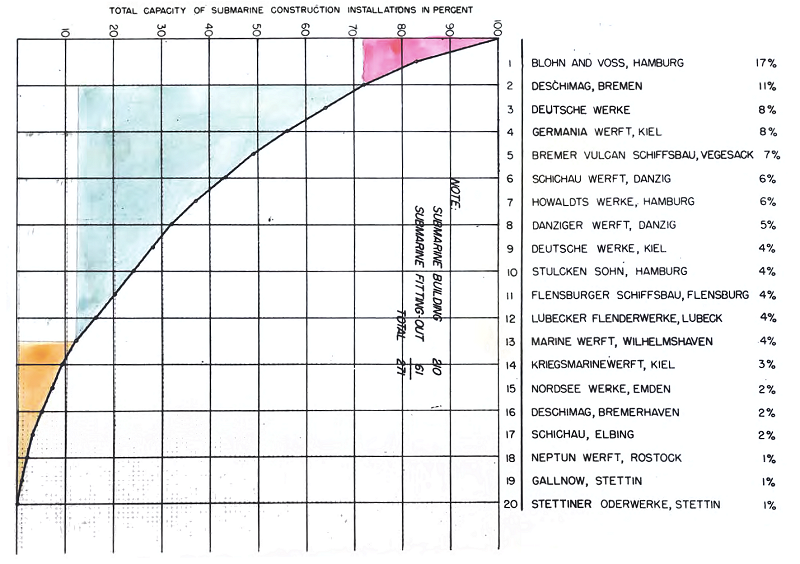
|
REQUIREMENTS FOR AIR ASCENDANCY Tab B European Theatre - Appendix G-IV Submarine Yards |
|
No. |
Place |
Name of Yard |
U-Boat Building |
Percent Total German Production |
||
|
On Slips |
Fitting Out |
Total |
||||
|
1. |
Hamburg |
Blohm & Voss |
36 |
9 |
45 |
17 |
|
2. |
Bremen |
Deschimag |
20 |
9 |
29 |
11 |
|
3. |
Hamburg |
Deutsche Werke (Finkenwarder) |
16 |
6 |
22 |
8 |
|
4. |
Kiel |
Germania Werft (Krupp) |
18 |
5 |
23 |
8 |
|
5. |
Vegesack |
Bremer Vulcan Schiffsbau |
14 |
4 |
18 |
7 |
|
6. |
Danzig |
Schichau Werft |
12 |
3 |
15 |
6 |
|
7. |
Hamburg |
Howaldts Werke |
16 |
1 |
17 |
6 |
|
8. |
Dansig |
Danziger Werft |
9 |
5 |
14 |
5 |
|
9. |
Kiel |
Deutsche Werke |
10 |
2 |
12 |
4 |
|
10. |
Hamburg |
Stulcken Sohn |
6 |
5 |
11 |
4 |
|
11. |
Flensburg |
Flensburger Schiffsbau |
8 |
3 |
11 |
4 |
|
12. |
Lubeck |
Lubecker Flenderwerke |
8 |
2 |
10 |
4 |
|
13. |
Wilhelmshaven |
Marine Werft |
10 |
1 |
11 |
4 |
|
14. |
Kiel |
Kriegsmarinewerft |
7 |
2 |
9 |
3 |
|
15. |
Emden |
Nordsee Werke |
6 |
1 |
7 |
2 |
|
16. |
Bremerhaven |
Deschimag (Seebeck) |
3 |
3 |
6 |
2 |
|
17. |
Elbing |
Schichau |
6 |
0 |
6 |
2 |
|
18. |
Rostock |
Neptun Werft |
2 |
0 |
2 |
1 |
|
19. |
Stettin |
Gollnow |
1 |
0 |
1 |
1 |
|
20. |
Stettin |
Stettiner Oderwerke |
2 |
0 |
2 |
1 |
|
TOTAL |
210 |
61 |
271 |
100 |
||
|
NOTES: 1. To be successful, attacks on these yards oust be heavy in order to damage irrevocably not only the submarines but also the shipyard facilities, cranes, gantries, workshops, etc. If all the yards are successfully attacked, the U-boat building program will be effectively brought to a standstill. 2. If the first seven yards are destroyed, the building program will be reduced by 63%. 3. Submarine Depots or Pens are not included in the list of targets as they are considered to be of such very heavy construction that it would be difficult actually to damage the submarines within. 4. Submarine components, such as Diesel Engines, Accumulators, Electrical Motors, etc., are not included in the list of targets, as the centers of production of these components are widely dispersed and it is felt that a more direct result will obtain by attacking the yards themselves. |
||||||
1. DESCRIPTION OF TARGETS
The main target comprises the slipways upon which submarines are built, and the primary aim is to destroy the submarines themselves. However, it is also desirable to destroy the shipyard facilities, including the cranes, gantries, workshops, etc., if possible. The lengths of the slips vary between about 250 and 1,000 feet, and they may be arranged in groups of several closely adjacent slips or in separate groups some distance apart at different points in the shipyards. A careful examination of the various yards indicates that the groups of slips may vary from 1 to 4, depending upon the size of the yard and the aiming points have been calculated appropriately.
2. NUMBER OF DIRECT HITS AND TYPE OF BOMBS REQUIRED
In order to effectively destroy both submarines and shipyard facilities it is considered that weight of attack should be laid on such as will give not less than 50 hits within the aiming point area of 1,000’ x 1,000’. The construction of the U-boats and shipyard plant is such that it is considered that bombs of at least 1,000 lb. will be required.
3. NUMBER OF SORTIES AND BOMBER FORCE REQUIRED
Based upon detailed calculations taking into account all operational factors involved in making attacks against highly defended targets with appropriate allowances for probabilities, aiming errors, losses, etc., etc., and allowing for the fact that with the very heavy weight of attack proposed the destruction will be so considerable that no further attacks would be necessary within a six month period, it appears that it would be necessary to have:
10,332 SORTIES
In order to carry out these sorties in 35 operational days, a force of:-
347 BOMBERS
must be set up.